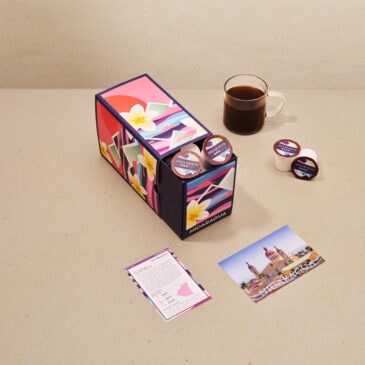The most enthusiastic and dedicated home baristas and coffee lovers might shudder and wince at the very thought of using pod coffee systems, but few can deny the convenience of making your morning cup of joe with a Keurig coffee machine.
Indeed, these popular brewers are often a kitchen staple, prized for their ability to keep up with your coffee habit quickly.

"The best coffee pod I've ever tasted"
Yes, we mean that. Finally, specialty coffee for your KCup machine, roasted fresh to your order by our friends at Atlas Coffee in Austin, TX! Get 50% OFF to try it with code ROASTYPODS
No, the cups of coffee they produce aren’t as flavorful as those made from, say, a pour-over or French press, but if all you’re after is getting a decent cup quickly, they can’t be beat — until it’s time to clean them.
The Keurig cleaning process can be a bit time-consuming and tedious, but it isn’t difficult.
Descaling your Keurig is the only way to keep your cup of coffee tasting great and your machine brewing for years to come, and we’re going to help you figure out the best way to get the job done.
Don’t forget to clean the needle, too!

It’s prime time…oh no
Keurig’s units are generally very reliable, but one issue afflicts them from time to time: the dreaded Prime message. That pesky little alert usually pops up when there’s an issue with the machine’s water reservoir.
You might want to start hurling insults at the machine when you see this message, especially when it’s the only thing standing between you and delicious coffee.
But before you start throwing a fit, you should know that this and most other brewing failures result from a lack of basic maintenance. Yep, we’re looking at you, descaling skippers.
We’ve got an article detailing how you can banish the Prime error message here, but the best way to prevent such problems from occurring in the first place is to descale your home brewing machine regularly.
The Details on Descaling
Descaling removes limescale, calcium, and other water minerals that have built up in your brewer over time, and it’s crucial if you plan on continuing to use your Keurig to curb your coffee cravings in record time.
Limescale buildup is the scourge of many kitchen appliances, including kettles, irons, and coffee machines, and mineral accumulation can leave your brew tasting unpleasant before eventually causing the device to fail.
Unfortunately, these things can occur even if you only use filtered, fresh water in your brewer.
Descaling Solution vs. Vinegar
Two cleaning agents have proven effective in removing mineral and scale buildup from Keurig coffee machines: Keurig’s branded descaling solution and vinegar.
When we say vinegar, we specifically mean white vinegar; keep your malt vinegar for your French fries and the balsamic or apple cider vinegar for your salad.
You probably already have a bottle of vinegar in your kitchen cupboard, but if you don’t, you can easily find it at any supermarket or grocery store.
You can even buy it online if you prefer. Keurig’s descaling solution is also available in-store or online, and it’s formulated specifically for use with the brand’s machines, so you know it’s a safe choice for a cleaning cycle.
Although Keurig’s descaling agent is more expensive than white vinegar, the brand says it can be used for more than just the descaling process. You can also use it to clean other kitchen items, like kettles and water heaters, not to mention it extends the life of your machine. So, it’s pretty safe to say it’s worth a few extra dollars.
But which one works best?
Before we can answer that question, we should walk you through each process. Then, you can make an informed decision on which solution is best for ridding your machine of calcium and mineral buildup and keeping it running smoothly.
Descaling With A White Vinegar Solution
Let’s look at the home remedy, the white vinegar option, first.
While this is the cheaper option, it’s also worth noting that if you ever need to use Keurig’s warranty to fix a problem with your machine, the company might not be too happy that you’ve been relying on vinegar rather than the brand’s specially formulated descaling product to keep your device at peak performance.
What You’ll Need:
- Dish soap
- White vinegar
- Clean water
- Clean, dry cloths
What To Do:
- Turn off the machine. Better still, unplug the appliance from the wall socket. (We care about your health and safety here at Roasty).
- Remove the coffee machine reservoir and its lid. Take off the mug stand and the K-Cup holder. If your machine has a removable drip tray, remove that too.
- Wash all the pieces you’ve removed in dish soap and warm water. Then, wipe the parts dry with a clean, non-abrasive cloth.
- Wipe down the rest of the machine’s surfaces with a clean, damp cloth. Remember to clean the area around the pod holder, too, as a small amount of gunk and spilled coffee grounds can accumulate here. Now, you can replace all the removable pieces and plug the machine back into the wall.
- Fill the reservoir halfway with white vinegar and top it off to the fill line with clean water.
- Place a mug in position and start the brew cycle, but don’t insert a K-Cup. Repeat this process until the reservoir is empty, dumping the contents out after each cycle. Circulating vinegar and hot water through the machine breaks down any accumulated limescale and mineral deposits.
- Once all the vinegar and water mixture has cycled through the machine, fill the reservoir with water, hit the brew button again, and repeat the process. Rinsing with water keeps your joe from tasting like vinegar. Now, your Keurig is ready to brew a cup of coffee, tea,hot chocolate, or whatever else you love to make with your machine!
How do I get the vinegar taste out of my Keurig after cleaning it?
If a water-only cleaning cycle doesn’t quite do the trick in removing the vinegar taste from your machine, run a reservoir full of water and a tablespoon of baking soda through the brewer, then give your machine at least a 30-minute rest before trying to make coffee.
Descaling With Keurig’s Solution
The procedure for descaling your brewer with Keurig’s solution pretty much follows the same simple steps as above, except you’ll substitute the vinegar for the descaling solution.
Consult your machine’s instruction manual or the directions on the solution’s bottle to see how much of the product you should pour into the reservoir.
You can use Keurig’s descaling product with automatic machines, manual machines, pod and K-Cup machines, and commercial brewers, too.
Reviews from other coffee aficionados declare you get a superior flavored coffee if you use this stuff instead of vinegar, so if you want to brew coffee that tastes as fresh and delicious as possible, this is probably your best bet.
Answering Your Keurig Cleaning Questions
How often should you descale your Keurig?
Ideally, you’ll go through your descaling routine every two to three months, more if your machine is used very frequently.
If you live in an area with hard water, you’ll need to descale your Keurig more regularly, as your tap water contains more limescale.
It can be challenging to remember when it’s time to get cleaning, which is why many Keurig coffee brewers have an automatic descaling reminder built into them. If your unit doesn’t have this function, though, make a note on your calendar so you don’t forget!
How often should you clean your Keurig?
Cleaning your Keuring on a regular basis is essential to ensuring your machine lasts for years to come and making sure your coffee tastes as great as the first brew. For best results, it’s recommended that you clean and descale your machine every 3-6 months.
Letting your machine go longer than six months before cleaning or descaling can result in an accumulation of limescale. This can cause your coffee to taste bad and can shorten your machine’s lifespan.
How often should you replace the filters?
There are two different Keurig filters to consider. The first of which is a coffee filter in the form of My K-Cup Reusable Coffee Filter. For best results, this should be emptied and cleaned after each use.
The second type of filter refers to the water filter cartridges. The individual water filter cartridges should be replaced every two months. The water filter holder should be part of your cleaning routine every 3-6 months.
Do you have to clean your Keurig if there is already a water filter?
Yes, you and your Keurig coffee machine still have to undergo the descaling process even if there is already a water filter.
Many Keurig coffee makers have built-in water filters, but these don’t excuse you from regular cleanings with some sort of descaling agent.
In fact, they add an extra step to your Keurig maintenance routine, as these water filters should be replaced every two months (though this could vary depending on how often you use your brewer).
Can I put my Keurig parts in the dishwasher?
You’ll have to consult the user manual that came with your coffee maker to see which parts, if any, of your specific brewer are dishwasher-safe. In general, the water reservoir, drip tray, and K-Cup holder can survive a low-temperature cycle on the top rack of the appliance.
If the water is too hot, though, there’s a chance of the plastic components melting, so if you don’t want to take that risk, just use warm, soapy water and a washcloth to scrub each part of the coffee machine by hand.
Generally, we recommend hand-washing all parts of your Keurig; it’s the best way to make sure nothing’s left behind in any of your brewer’s hard-to-reach places.
How do you remove the Keurig water reservoir?
While most Keurigs allow for removable water reservoirs, a few do not. For instance, the Keurig K-Mini, K-Mini Plus, and K-Slim do not have removable water reservoirs. Instead, the size of your coffee is decided by the amount of water you put into the machine.
To remove a water reservoir on a machine that allows it, gently lift the empty reservoir off the slot in the machine.
When you replace the water reservoir, make sure it connects back to place correctly to ensure your Keurig will not leak with your next brew.
How do you remove calcium deposits from Keurig water reservoirs?
If you notice calcium deposits on the inside of your Keurig water reservoir, the first step is to remove the reservoir and clean it with warm water and dish soap.
Gently scrub the calcium deposits with a soft sponge. This is also a sign that you should be cleaning your Keurig machine more regularly.
After you’ve rinsed the soap out of the water reservoir, fill the reservoir with a mixture of water and distilled white vinegar and descale your Keurig machine. The white vinegar mixture should remove any leftover calcium deposits you missed with the first round of cleaning.
How do you change the Keurig water filter?
First, remove the old Keurig water filter. Lift the water reservoir out of its slot and remove the water filter handle. To open the water filter handle, remove the lower filter handle from the upper filter handle and dispose of the old filter.
Take your new water filter cartridge and soak it in water for five minutes. After the five minutes is up, rinse the cartridge under cold water for 60 seconds. Replace the old cartridge with the new one, and snap the filter handle back together.
Place the water reservoir back into its slot and put the water filter handle back in the reservoir. Push firmly to lock the handle back into place.
How do you get mold out of a Keurig?
If you see mold on your Keurig or inside the water reservoir, that is a clear sign you need to be better at cleaning your machine. It also means it’s time to deep clean your machine.
First, remove all removable parts of your machine, like the water reservoir and drip tray. Place these in a mixture of equal parts water and distilled white vinegar. Let these pieces soak for a few minutes before scrubbing with a toothbrush to remove any mold.
After these are cleaned and rinsed, take a second to wipe down the outside of your machine and ensure it’s clean. Replace the drip tray and water reservoir, and fill the reservoir with a mixture of equal parts water and distilled white vinegar. Descale your machine to remove any mold that may be on the inside of your machine.
While it may be tempting to use bleach or something stronger to remove the mold, distilled white vinegar is the best option. Bleach is harsh and corrosive and may compromise the integrity of your machine. Additionally, it can be harmful to your health if you do not rinse the bleach fully from your machine.
How do you reset a Keurig after descaling?
To reset your Keurig, first, open and close the level. Next, turn off and unplug your machine and remove the water reservoir (see above for instructions on removable).
Finally, replace the water reservoir, plug the machine back into the wall, and press the power button. Your Keurig should now be functioning correctly.
How long should you let vinegar sit in your Keurig?
If you have not descaled your machine regularly and are experiencing an immense amount of calcium build-up, you can get rid of this by letting a mixture of equal parts water and vinegar sit in your machine.
Since vinegar is acidic, do not leave it sitting in your machine for longer than three hours.
How do you get ants out of a Keurig?
No one likes ants in your coffee, and it can be scary to see ants infesting your Keurig machine. First, remove the water reservoir and drip tray and clean thoroughly with warm water and dish soap.
Next, replace the water reservoir and drip tray. Fill the water reservoir with a mixture of equal parts water and distilled white vinegar and run a descaling cycle to flush out any ants inside the machine. Repeat this step until all ants are removed.
It might be beneficial to also clean the counter your Keurig sits on to make sure there is nothing left attracting the ants.
How do you unclog a Keurig?
To unclog a Keurig, you will need a needle or toothpick. Make sure your machine is turned off, cool, and located in a well-lit area.
Take your needle or toothpick and gently scrape the clogged coffee grounds from the inside of the puncture needle. If you are having trouble removing the clogged coffee grounds, soak them in warm water for a few minutes to loosen the clog. Run a descaling cycle to ensure the clog is fully removed.
Do this gently as the needles are incredibly sharp.
How do I clean the inside of my Keurig?
Cleaning the inside of your Keurig is also referred to as descaling. With constant use, limescale buildup will accumulate on the inside of your machine. This can cause your machine to leak when brewing or your coffee to taste bad.
When it comes to descaling, you have two options. The first is to use the descaling solution sold through Keurig. After filling the water reservoir with the amount of descaling solution printed on the bottle, run a descaling cycle to clean the inside of your machine.
If you choose not to use the Keurig descaling solution, you could make your own. Fill the water reservoir with an equal mixture of water and distilled white vinegar. Run a descaling cycle to clean the inside of your machine.
No matter which option you choose, be sure you run a few rinse cycles to make sure your next cup of coffee does not taste like vinegar or descaling solution.
Why does my coffee taste sour after descaling?
If your Keurig tastes sour after descaling, that’s a good indicator you did not properly rinse your machine.
Fill the water reservoir with fresh water and keep running a rinse cycle until the water reservoir has been emptied. Depending on how much solution or vinegar you used when descaling, you may need to do this a few times to rid your Keurig of any sour tastes fully.
How do I clean Keurig needles?
Your Keurig needle may need to be cleaned if you’re experiencing leaking when brewing or longer than normal brew times.
The needles can be found on the inside of the K-Cup holders on the top and button. These needles are used to puncture the K-Cups and force water through to brew a cup of coffee. Sometimes, these get clogged with accumulated coffee grounds.
To clean the needle, you will need a needle or toothpick. Make sure your machine is turned off, cool, and located in a well-lit area.
Take your needle or toothpick and gently scrape the clogged coffee grounds from the inside of the puncture needle. If you are having trouble removing the clogged coffee grounds, soak them in warm water for a few minutes to loosen the clog.
Run a descaling cycle to ensure the clog is fully removed and the needle is cleaned.
Do this gently as the needles are incredibly sharp.
What happens if you don’t descale your Keurig?
It might be tempting to skip out on descaling your Keurig but trust us, taking a few extra minutes to make sure everything’s clean is worth it.
Descaling guarantees your machine will consistently give you the best-tasting coffee possible, as it keeps calcium deposits from building up and clogging your machine.
The more calcium and other water minerals build up in your machine, the less efficiently your Keurig will run, and pretty soon, you’ll have to invest in a brand new brewer.
To put it plainly: descaling your Keurig prolongs its life and spares you from having to suffer through cups of off-tasting coffee.
Is Keurig descaling solution toxic?
While the cleaning solution is safe enough for use in your beloved single-serve coffee maker, it can be harmful if it’s swallowed, inhaled, or makes contact with your skin.
However, symptoms and reactions could be delayed, so your best bet is to seek medical advice right away if any of these things happen. Use it only for its intended purpose and follow the instructions carefully, though, and you should be fine.
The Bottom Line
| Descaling Solution | White Vinegar |
|---|---|
| Pricier, but guarantees your warranty if your machine breaks | Cheaper, uses already at-home ingredients, but could void warranty |
| Preserves a better flavor for subsequently brewed coffee | Can leave behind a vinegar taste, requiring extra cleaning |
| Good for the long run | Less effective long-term |
Regularly descaling your Keurig will help it run much smoother and last longer.
Each brewer descaling solution has its own set of pros and cons; it’s up to you to decide which is best for you.
White vinegar is probably your best bet if you want something cheap and readily available in a pinch. However, the long-term effectiveness of this method isn’t quite as impressive.
Keurig’s descaling solution is more expensive than vinegar. But, since it’s formulated by and for Keurig, you can trust that it will keep your machine running reliably if you use it at the recommended every two to three months.
Though the process is pretty much the same whether you use white vinegar or Keurig’s solution, we’d recommend using Keurig’s product over vinegar.
Sure, it’s a little more expensive to buy, but if it helps you enjoy a better coffee flavor, we think it’s worth the investment. Plus, your machine won’t fail because of that Prime error message, and your warranty will remain valid in the unlikely event of a problem down the road.
Cleaning, in between descaling, helps to ensure your Keurig produces better, stronger, more delicious cups of coffee.
We hope this guide has provided you with great tips to make this process run smoother.
Happy caffeinating!








